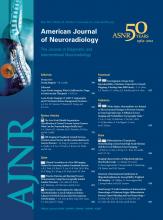Abstract
BACKGROUND AND PURPOSE: PRES-related vasogenic edema is potentially reversible while hemorrhage occurs in only 15.2%–17.3% of patients. However, the true incidence of hemorrhage could be higher when SWI is considered. Thus, we set out to determine the incidence of MH, SAH, and IPH in PRES by using SWI and to particularly evaluate whether such MHs are reversible.
MATERIALS AND METHODS: Thirty-one patients with PRES and SWI were included, 17 having follow-up SWI. Two neuroradiologists reviewed SWI, FLAIR, DWI, and CE-T1WI. The presence and number of MHs (<5 mm) on SWI, SAH, and IPH (>5 mm) were recorded at presentation and follow-up. We evaluated associations between the presence of MH on SWI and DWI lesions, SAH, IPH, contrast enhancement, and MR imaging severity.
RESULTS: Hemorrhage was present in 20/31 patients (64.5%), with MHs on SWI in 18/31 (58.1%) at presentation and in 11/17 (64.7%) at follow-up. SAH was present in 3/31 on SWI and 4/31 on FLAIR, while 2/31 had IPH. At follow-up, no patients had acquired new MHs; 2/5 MHs in 1 patient resolved. Four patients with available SWI before PRES developed MHs after PRES onset. No association was found between the presence of MHs on SWI and DWI, SAH, IPH, enhancement, and MR imaging severity (all P > .05).
CONCLUSIONS: SWI showed a higher rate of MH than previously described, underscoring the potential of SWI in evaluating PRES. Such MHs typically persist and may develop after PRES onset. However, the clinical relevance of MHs in PRES is yet to be determined. We propose that MHs in PRES relate to endothelial cell dysfunction.
ABBREVIATIONS:
- CE
- contrast-enhanced
- INR
- international normalized ratio
- IPH
- intraparenchymal hemorrhage
- MH
- microhemorrhage
- PRES
- posterior reversible encephalopathy syndrome
- T2* GRE
- T2* gradient-recalled echo
- © 2012 by American Journal of Neuroradiology












